tow YAMAHA KODIAK 700 2017 Owners Manual
[x] Cancel search | Manufacturer: YAMAHA, Model Year: 2017, Model line: KODIAK 700, Model: YAMAHA KODIAK 700 2017Pages: 178, PDF Size: 4.61 MB
Page 18 of 178
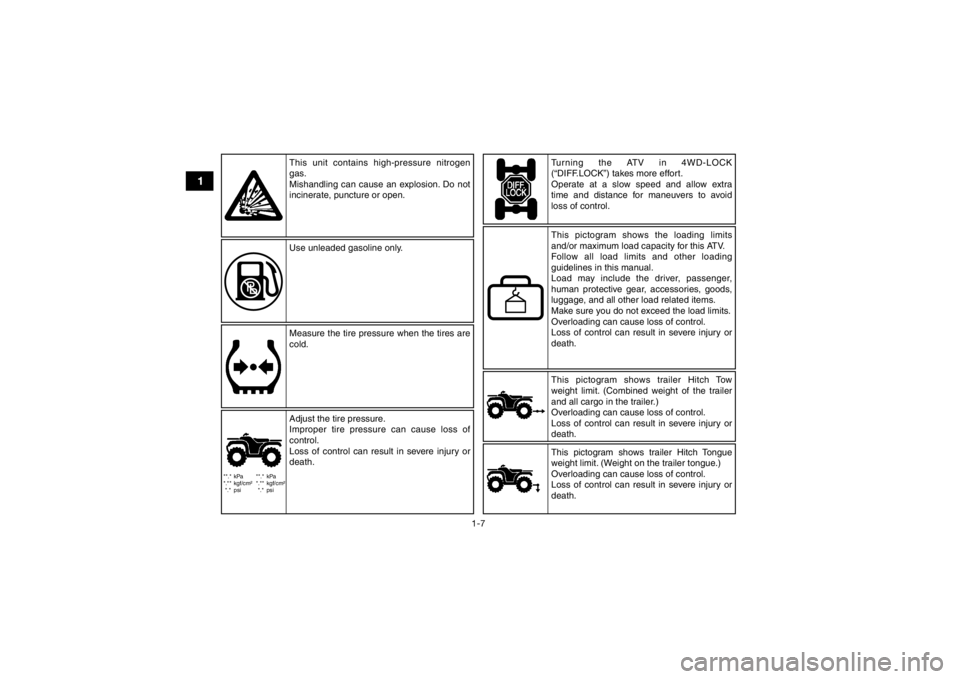
1-7
1
**.* kPa
*.** kgf/cm²*.* psi **.* kPa
*.** kgf/cm²
*.* psi
This pictogram shows trailer Hitch Tow
weight limit. (Combined weight of the trailer
and all cargo in the trailer.)
Overloading can cause loss of control.
Loss of control can result in severe injury or
death.
This unit contains high-pressure nitrogen
gas.
Mishandling can cause an explosion. Do not
incinerate, puncture or open.
Use unleaded gasoline only.
Measure the tire pressure when the tires are
cold.
Turning the ATV in 4WD-LOCK
(“DIFF.LOCK”) takes more effort.
Operate at a slow speed and allow extra
time and distance for maneuvers to avoid
loss of control.
Adjust the tire pressure.
Improper tire pressure can cause loss of
control.
Loss of control can result in severe injury or
death. This pictogram shows the loading limits
and/or maximum load capacity for this ATV.
Follow all load limits and other loading
guidelines in this manual.
Load may include the driver, passenger,
human protective gear, accessories, goods,
luggage, and all other load related items.
Make sure you do not exceed the load limits.
Overloading can cause loss of control.
Loss of control can result in severe injury or
death.
This pictogram shows trailer Hitch Tongue
weight limit. (Weight on the trailer tongue.)
Overloading can cause loss of control.
Loss of control can result in severe injury or
death.
UB1661E0.book Page 7 Thursday, May 12, 2016 2:47 PM
Page 22 of 178
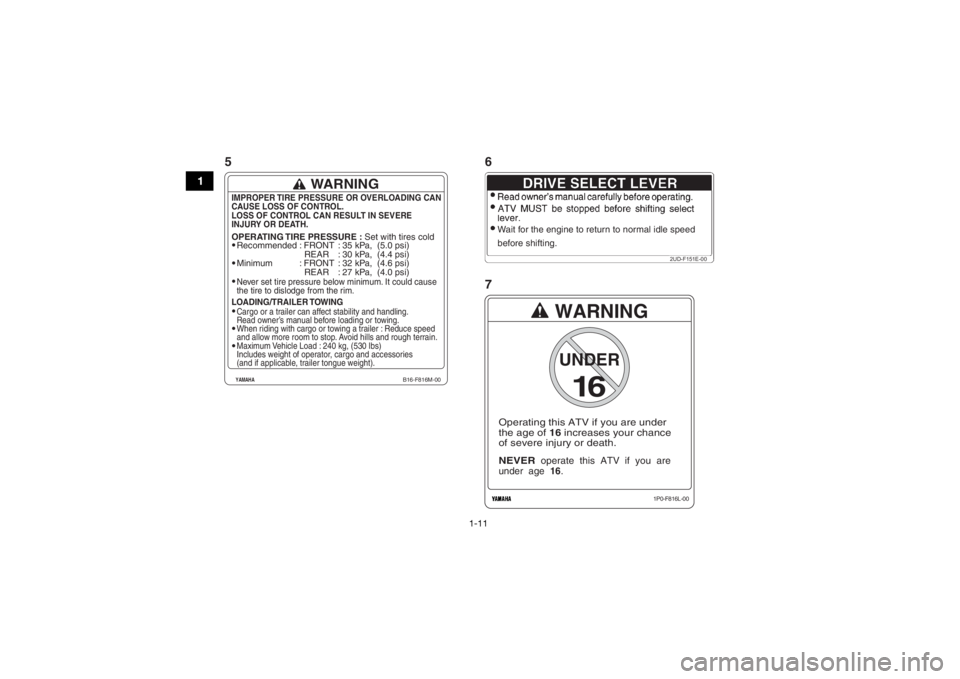
1-11
1
Recommended
Minimum: FRONT
REAR
: FRONT
REAR: 35 kPa, (5.0 psi)
: 30 kPa, (4.4 psi)
: 32 kPa, (4.6 psi)
: 27 kPa, (4.0 psi)Never set tire pressure below minimum. It could cause
the tire to dislodge from the rim.Cargo or a trailer can affect stability and handling.
Read owner’s manual before loading or towing.
When riding with cargo or towing a trailer : Reduce speed
and allow more room to stop. Avoid hills and rough terrain.
Maximum Vehicle Load : 240 kg, (530 lbs)
Includes weight of operator, cargo and accessories
(and if applicable, trailer tongue weight).
WARNING
B16-F816M-00
YAMAHAIMPROPER TIRE PRESSURE OR OVERLOADING CAN
CAUSE LOSS OF CONTROL.
LOSS OF CONTROL CAN RESULT IN SEVERE
INJURY OR DEATH.OPERATING TIRE PRESSURE : Set with tires coldLOADING/TRAILER TOWING
WARNING
NEVER
operate this ATV if you are
under age 16.Operating this ATV if you are under
the age of 16 increases your chance
of severe injury or death.
16
UNDER
1P0-F816L-00
Wait for the engine to return to normal idle speed
before shifting.
2UD-F151E-00
56
7UB1661E0.book Page 11 Thursday, May 12, 2016 2:47 PM
Page 40 of 178
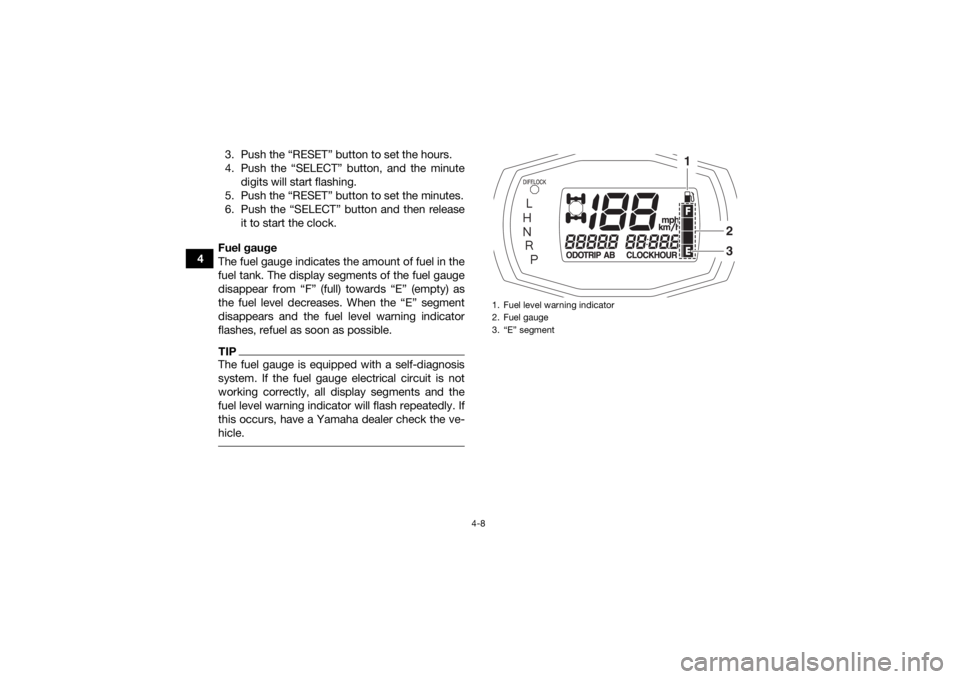
4-8
43. Push the “RESET” button to set the hours.
4. Push the “SELECT” button, and the minute
digits will start flashing.
5. Push the “RESET” button to set the minutes.
6. Push the “SELECT” button and then release it to start the clock.
Fuel gauge
The fuel gauge indicates the amount of fuel in the
fuel tank. The display segments of the fuel gauge
disappear from “F” (full) towards “E” (empty) as
the fuel level decreases. When the “E” segment
disappears and the fuel level warning indicator
flashes, refuel as soon as possible.
TIPThe fuel gauge is equipped with a self-diagnosis
system. If the fuel gauge electrical circuit is not
working correctly, all display segments and the
fuel level warning indicator will flash repeatedly. If
this occurs, have a Yamaha dealer check the ve-
hicle.
1. Fuel level warning indicator
2. Fuel gauge
3. “E” segment
1
23
UB1661E0.book Page 8 Thursday, May 12, 2016 2:47 PM
Page 50 of 178
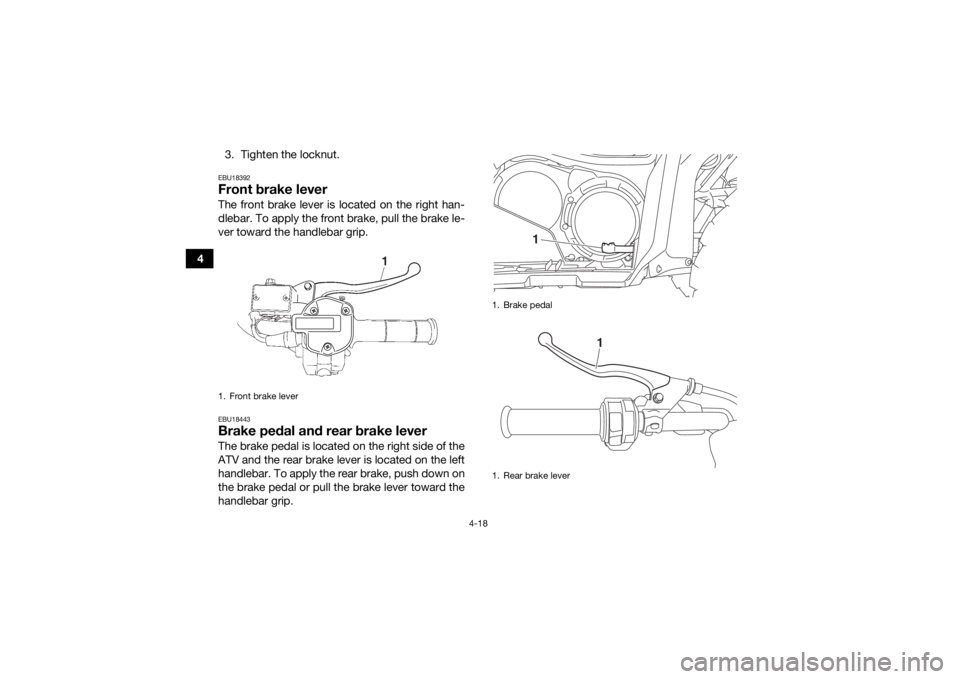
4-18
43. Tighten the locknut.
EBU18392Front brake leverThe front brake lever is located on the right han-
dlebar. To apply the front brake, pull the brake le-
ver toward the handlebar grip.EBU18443Brake pedal and rear brake leverThe brake pedal is located on the right side of the
ATV and the rear brake lever is located on the left
handlebar. To apply the rear brake, push down on
the brake pedal or pull the brake lever toward the
handlebar grip.1. Front brake lever
1. Brake pedal
1. Rear brake lever
1
1
UB1661E0.book Page 18 Thursday, May 12, 2016 2:47 PM
Page 57 of 178
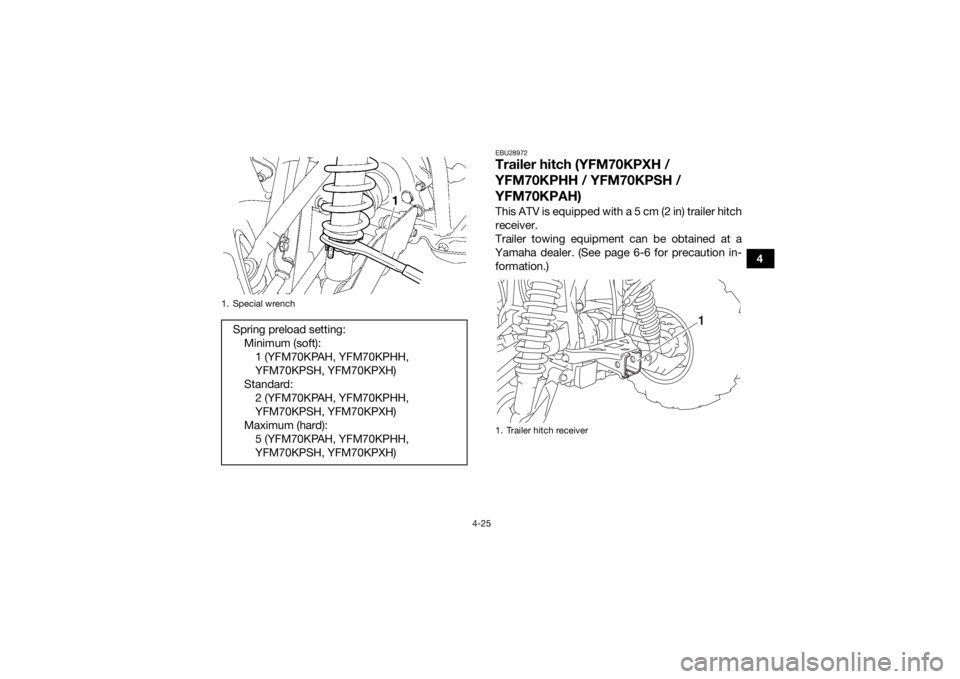
4-25
4
EBU28972Trailer hitch (YFM70KPXH /
YFM70KPHH / YFM70KPSH /
YFM70KPAH)This ATV is equipped with a 5 cm (2 in) trailer hitch
receiver.
Trailer towing equipment can be obtained at a
Yamaha dealer. (See page 6-6 for precaution in- formation.)
1. Special wrenchSpring preload setting: Minimum (soft):1 (YFM70KPAH, YFM70KPHH,
YFM70KPSH, YFM70KPXH)
Standard: 2 (YFM70KPAH, YFM70KPHH,
YFM70KPSH, YFM70KPXH)
Maximum (hard): 5 (YFM70KPAH, YFM70KPHH,
YFM70KPSH, YFM70KPXH)
1. Trailer hitch receiver
1
UB1661E0.book Page 25 Thursday, May 12, 2016 2:47 PM
Page 71 of 178

6-6
6
and accessories or offer other modifications for
Yamaha vehicles. Yamaha is not in a position to test the products that these aftermarket compa-
nies produce. Therefore, Yamaha can neither en-
dorse nor recommend the use of accessories not
sold by Yamaha or modifications not specifically
recommended by Yamaha, even if sold and in-
stalled by a Yamaha dealer.
Aftermarket parts, accessories, and modifica-
tions
While you may find aftermarket products similar in
design and quality to genuine Yamaha Accesso-
ries, recognize that some aftermarket accessories
or modifications are not suitable because of po-
tential safety hazards to you or others. Installing
aftermarket products or having other modifica-
tions performed to your ATV that change any of
the vehicle’s design or operation characteristics
can put you and others at greater risk of serious
injury or death. You are responsible for injuries re-
lated to changes in the vehicle.
Keep the following in mind when considering an
accessory or operating an ATV which has acces-
sories.
Accessories should be rigidly and securely
mounted. An accessory which can shift position
or come off while you are riding could affect
your ability to control the ATV.
Do not mount an accessory where it could inter-
fere with your ability to control the ATV. Exam-
ples include (but are not limited to) a heavy or
bulky object attached to the handlebars which
could make steering difficult, an accessory that
limits your ability to move around on the seat, or
one that limits your view.
Use extra caution when riding an ATV with ac-
cessories. The ATV may handle differently than
it does without accessories.
EBU21042Loading
WARNING
EWB00821Never exceed the stated load capacity for this
ATV. Overloading this ATV or carrying or tow-
ing cargo improperly could cause changes in
ATV handling which could lead to an accident.
Cargo should be properly distributed and se-
UB1661E0.book Page 6 Thursday, May 12, 2016 2:47 PM
Page 72 of 178

6-7
6curely attached. Reduce speed when carrying
cargo or pulling a trailer. Allow greater dis-
tance for braking.
Cargo or a trailer can change the stability and han-
dling of an ATV.
You must use common sense and good judgment
when carrying cargo or towing a trailer. Keep the
following points in mind:
Never exceed the weight limits shown. An over-
loaded ATV can be unstable.
Do not exceed the maximum tongue weight.
You can measure tongue weight with a bath-
room scale. Put the tongue of the loaded trailer
on the scale with the tongue at hitch height. Ad-
just the load in the trailer, if necessary, to reduce
the weight on the hitch. If you are carrying cargo
and towing a trailer, include the tongue weight
in the maximum ATV load limit. MAXIMUM LOADING LIMIT
ATV loading limit (total weight of rider, car-
go, accessories, and tongue):240.0 kg (530 lb)
Front carrier: 50.0 kg (110 lb)
Rear carrier: 90.0 kg (198 lb)
Storage compartment: 4.0 kg (9 lb)
Trailer hitch: Pulling load (total weight of trailer and
cargo):5880 N (600 kgf, 1322 lbf)
Tongue weight (vertical weight on trailer
hitch point): 147 N (15 kgf, 33 lbf)UB1661E0.book Page 7 Thursday, May 12, 2016 2:47 PM
Page 73 of 178

6-8
6
Load cargo on the carriers as close to the center
of the ATV as possible. Put cargo at the rear of
the front carrier, at the front of the rear carrier,
and center it.
Tie down cargo securely to the carriers. Make
sure cargo in the trailer cannot move around. A
shifting load can cause an accident.
Make sure the load does not interfere with con-
trols or your ability to see where you are going.
Ride more slowly than you would without a
load. The more weight you carry, the slower you
should go. Although conditions vary, it is good
practice not to exceed low range whenever you
are carrying heavier loads or when towing a
trailer.
Allow more braking distance. A heavier ATV
takes longer to stop.
Avoid making sharp turns unless at very slow
speeds.
Avoid hills and rough terrain. Choose terrain
carefully. Added weight affects the stability and
handling of the ATV.
UB1661E0.book Page 8 Thursday, May 12, 2016 2:47 PM
Page 79 of 178
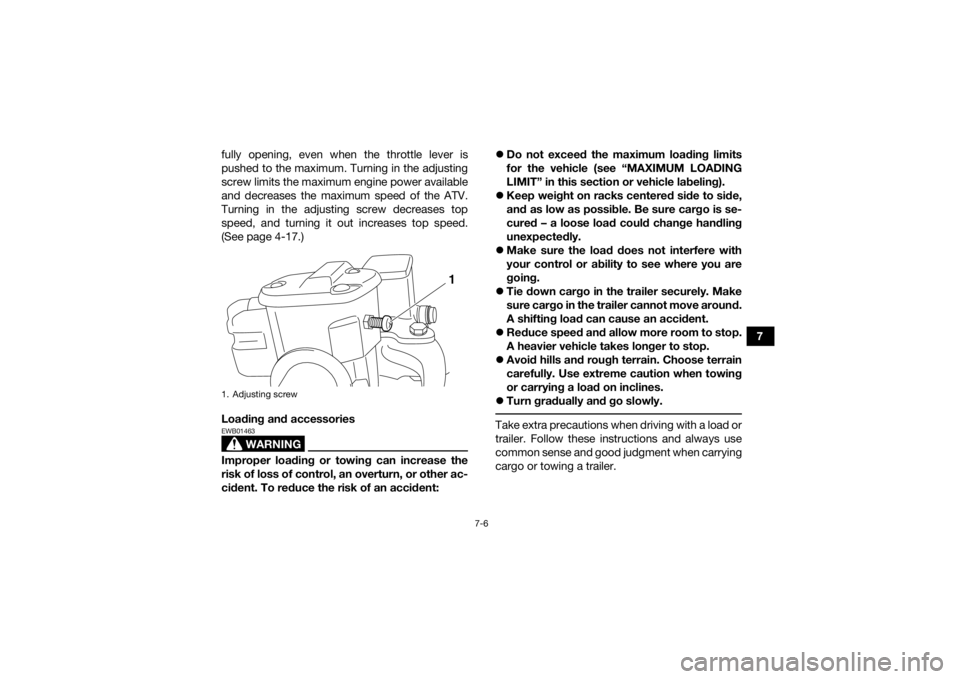
7-6
7
fully opening, even when the throttle lever is
pushed to the maximum. Turning in the adjusting
screw limits the maximum engine power available
and decreases the maximum speed of the ATV.
Turning in the adjusting screw decreases top
speed, and turning it out increases top speed.
(See page 4-17.)
Loading and accessories
WARNING
EWB01463Improper loading or towing can increase the
risk of loss of control, an overturn, or other ac-
cident. To reduce the risk of an accident:
Do not exceed the maximum loading limits
for the vehicle (see “MAXIMUM LOADING
LIMIT” in this section or vehicle labeling).
Keep weight on racks centered side to side,
and as low as possible. Be sure cargo is se-
cured – a loose load could change handling
unexpectedly.
Make sure the load does not interfere with
your control or ability to see where you are
going.
Tie down cargo in the trailer securely. Make
sure cargo in the trailer cannot move around.
A shifting load can cause an accident.
Reduce speed and allow more room to stop.
A heavier vehicle takes longer to stop.
Avoid hills and rough terrain. Choose terrain
carefully. Use extreme caution when towing
or carrying a load on inclines.
Turn gradually and go slowly.
Take extra precautions when driving with a load or
trailer. Follow these instructions and always use
common sense and good judgment when carrying
cargo or towing a trailer.
1. Adjusting screw
1
UB1661E0.book Page 6 Thursday, May 12, 2016 2:47 PM
Page 80 of 178
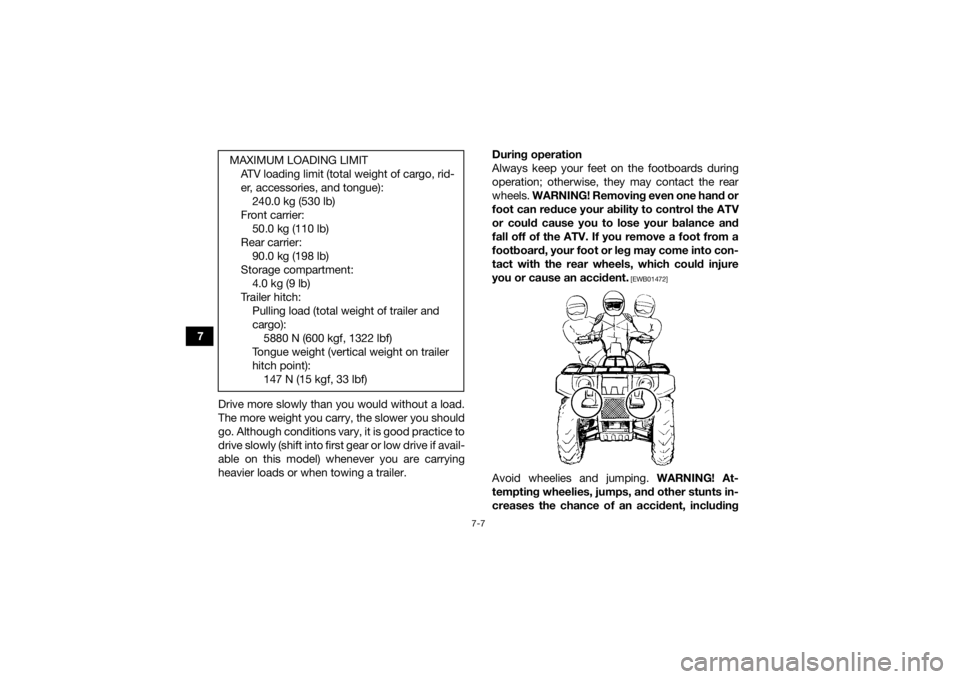
7-7
7Drive more slowly than you would without a load.
The more weight you carry, the slower you should
go. Although conditions vary, it is good practice to
drive slowly (shift into first gear or low drive if avail-
able on this model) whenever you are carrying
heavier loads or when towing a trailer. During operation
Always keep your feet on the footboards during
operation; otherwise, they may contact the rear
wheels.
WARNING! Removing even one hand or
foot can reduce your ability to control the ATV
or could cause you to lose your balance and
fall off of the ATV. If you remove a foot from a
footboard, your foot or leg may come into con-
tact with the rear wheels, which could injure
you or cause an accident.
[EWB01472]
Avoid wheelies and jumping. WARNING! At-
tempting wheelies, jumps, and other stunts in-
creases the chance of an accident, including
MAXIMUM LOADING LIMIT
ATV loading limit (total weight of cargo, rid-
er, accessories, and tongue):240.0 kg (530 lb)
Front carrier: 50.0 kg (110 lb)
Rear carrier: 90.0 kg (198 lb)
Storage compartment: 4.0 kg (9 lb)
Trailer hitch: Pulling load (total weight of trailer and
cargo):5880 N (600 kgf, 1322 lbf)
Tongue weight (vertical weight on trailer
hitch point): 147 N (15 kgf, 33 lbf)
UB1661E0.book Page 7 Thursday, May 12, 2016 2:47 PM